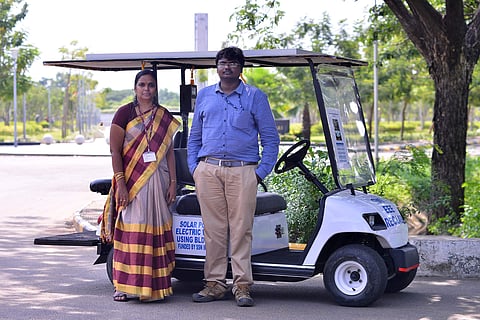

Everybody loves speed, but add green to that mean machine and the market can go crazy. But more than market value it is the need for a self-sustaining, environmentally operated vehicle that charged Dr R Seyezhai and her PhD student, Bharathi Sanker, to produce a unique cart.
Dr Seyezhai, it's very interesting to see you spearheading this project, a reality in the country. What brought you to this field?
I'm an electronics and communication engineer and this is what drives me. I have a PHD in power electronics and had a passion to design electronics. I owe a lot to my parents who are both teachers. My father is my role model and moulded me each day and made me contribute to society. This made me think of something unique which doesn't exist in the current scenario.
Tell us about your solar panel?
It is a high-level solar panel with the charging capability of 8 amps, which charges the battery within 7-8 hours.
What additional developments do you plan for this?
Currently, solar charging from the floating level, solar-panel on the roof, takes at least 7 hours to charge the cart. We plan to replace the lead-acid battery with a lithium-ion battery later. This will not only speed-up charging time but also increase range and speed.
What is the cart's need for speed?
Currently, when fully charged with lead-acid batteries, is capable of going at 70 kms on a single charge with a full load and reach a maximum speed of 40 kmph. Current battery-operated carts in the market that do employ the DC drive are not capable of reaching this speed.
What is the new technology that makes this the first of its kind in India?
The controller for the motor is a new one which regulates the speed of the motor as well as from the solar which has to charge the battery. So the output voltage of the solar panel has to be maintained constantly. Now we have a controller which will charge the battery. If you travel in off-road conditions, till 2 pm only will you have radiation and get maximum power. We have done this for the source as well as the motor.
What is so unique about this innovation excluding the whole solar factor?
The mega-innovation in creating this vehicle is the development of an advanced electric drive using a brushless DC motor. Using the motor will greatly boost the car's performance and result in higher efficiency, reduce maintenance, weight and operating and manufacturing-related costs.
Has this invention or Bharath's participation actually acted as a green signal for others?
We, a team of researchers and I, started working on this in 2013 and Bharathi has been a most dedicated student. He spent a lot of time in the lab and has put in a lot of effort and dedication to the project. He'd always call me with new queries and observations. He has inspired so many students that those from first and second year come to us and tell us they want to also undertake projects. This coupled with the freedom given to students by the college encourages many students to pursue their studies here.
How does this work? How do you get the college or administration to accept your ideas?
We have now started allowing even first and second-year students to research and propose ideas. We have a set panel that reviews these proposals and if accepted, get funds from the college or an external source.
Is it easy to financially manage this plus the additions you plan to fit in?
A GPS and an automated machine are highly funded, very well designed and develop the prototype clearly.
What is the process?
First, we write the concept on paper, then make a model, then turn it into a product and then work further.
How does funding work? What is the procedure?
Students can apply for external funding and up to a certain amount, it is not difficult. But if we go for mass-manufacturing and start-up then we need engine funding, a lot of formalities follow. For a collective approach, total funding is usually received from external agencies. We received at least Rs 33 crores from external agencies.
So how does funding work?
When they fund you they ask for a special component, so they might have rights to it. This helps them if the product goes into the market. Any idea is shared and we use facilities, not limited to our own department, which will be used to test and assess the product. So we're using all the infrastructure available in college. After a particular level, every external fund-source has some stakes attached.
What was the solar project funded under?
We have a faculty scheme, which is what the solar car project comes under. We got around 4.5 lakhs of which we spent around 1.5 lakhs for the initial steps like buying etc. the other three lakhs we kept for development.
Have you expressed interest in acquiring such parts from the market or other manufacturers before?
Informally, at exhibitions we have but this requires a much more detailed, business plan development. Once we decide that we want to go for a startup, which I think we are now moving towards. Then we like to work on the business planning and a financial knowledge and then dedicate to a potential investor. After a point, more than the technical it is the financial knowledge and to find a potential investor. After a point, more than the technical aspect it is the financial and commercial angle that will determine further progress.
What was the solar project funded under?
We have a faculty scheme, which is what the solar car project comes under. We got around 4.5 lakhs of which we spent around 1.5 lakhs for the initial steps like buying etc. the other three lakhs we kept for development.
